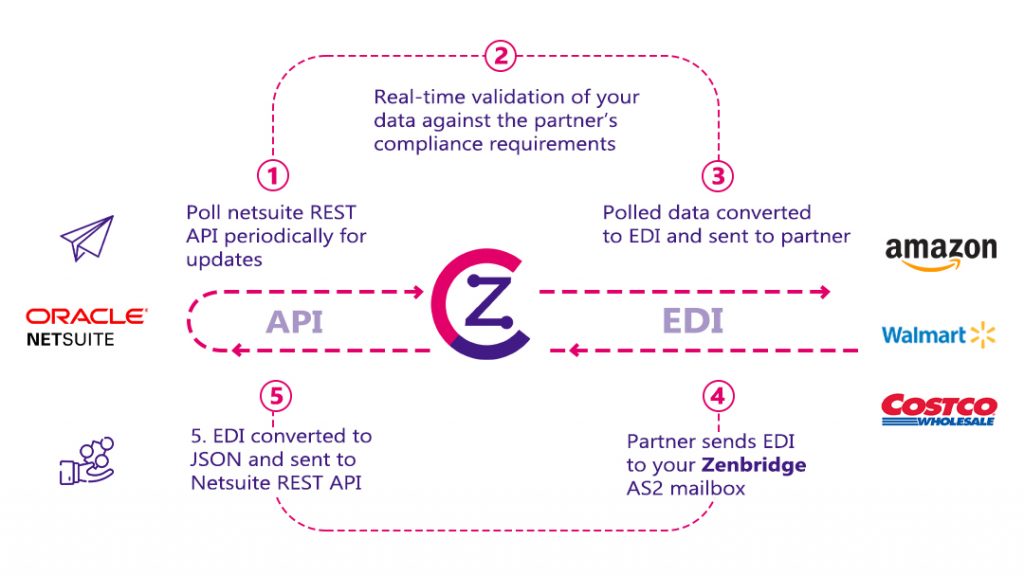
NetSuite EDI Integration- A Complete Setup Guide
On November 17, 2021 by ZenbridgeIntroduction
Oracle NetSuite ERP is reportedly one of the most well-known cloud-based ERPs for rapidly expanding businesses in 2025. It is a unified business management suite that offers support with services like financials, accounting, CRM & eCommerce. NetSuite ERP stands out from its competitors as its built-in functionality allows it to support multiple applications under one platform, including NetSuite EDI Integrations, thus reducing costs and enhancing productivity. The major differentiator lies in the easily customizable dashboards, which are essential for efficient operations with NetSuite EDI partners.
NetSuite EDI Integration Options
NetSuite EDI integrations are customizable according to your partners (Retail, 3PL, Transportation, etc.). However, NetSuite does not have an in-built EDI capability. Usually, NetSuite EDI Integrations are carried out using an external EDI platform or EDI service, which is common among NetSuite EDI partners. NetSuite lets you integrate with EDI platforms through:
- SOAP (Simple Object Access Protocol)
- REST-based APIs
The most preferred method of integration is REST APIs as modern-day developers are habituated to using this.
NetSuite REST API overview
NetSuite follows a particular design pattern to request or make an API call. Here are some important design features of NetSuite’s REST-based API:
- It’s a CRUD-based API that has endpoints to Create, Read, Update and Delete
- REST APIs use Uniform Resource Identifiers (URIs) to address resources. This is a typical API URI to fetch a sales order numbered 8689
It also uses HATEOAS (Hypermedia as the Engine of Application State), which distinguishes it from other network application architectures. With HATEOAS, you can interact with other network applications to fetch information dynamically through hypermedia.
Let’s say you’re fetching sales order data that in turn has sub-records like billing information, customer information, etc. Instead of giving the data in an expanded form, the API provides the URIs. You can use this URI to make another API call to fetch the billing information of the sales order.
NetSuite REST API Beta Features:
NetSuite also has some other APIs in the BETA phase, of which there is one interesting feature called the transform API. It lets you convert one record type into another, which can be useful when working with NetSuite EDI partners. For example, you can convert a sales order into an invoice.
For example, you can convert a sales order into an invoice. The only downside here is that they can scrap these BETA features without notifying you. So it makes sense to speak to your NetSuite support contact about their plans.
The other APIs in the BETA Program include:
- Transfer Order
- Return Authorization
- Assemble Item
- Vendor
- Credit Memo
- Inventory Count
- Partner
NetSuite Tracking Events
Traditionally there are a couple of ways to track events that happen inside NetSuite ERP or any Cloud-based ERP for that matter:
- Webhooks:
A webhook is a way of invoking an API callback URI for a given event. For example, you can invoke a webhook when a new Purchase order is created inside your ERP system. So when a change happens inside your system you can notify/track the changes to the API URI defined in your webhook setting. The bad news is, the webhook feature is not available in NetSuite yet.
- Polling:
Polling your NetSuite environment periodically may not be elegant but it works in some cases. It could be once every minute or every 30 minutes depending on your process and convenience.
- Suite Script:
This is the closest alternative to webhook. NetSuite has something called SuiteScripts. They are user event scripts that are executed on the NetSuite server. You can execute custom scripts on events such as create, load, update, copy, delete or submit. It is based on javascript with additional modules and features. So if you are familiar with Javascript, you should be able to handle it.
It supports most of the standard and custom records with exceptions in storing personal identification like a driver’s license or passport and other govt. Issued IDs.
How to set up the NetSuite REST API?
There are three high-level steps to follow for setting up the NetSuite REST API:
- Create a role for REST API
- Create a Custom Integration Manager
- Create access tokens with the integration manager and role
- Create a role for REST API
Create a role where you can define the permissions, and RESTrictions with different levels (View, edit, full, etc) for permissions. These permissions are applied to Transactions, (Bill, invoice, SO, PO, etc.) reports lists, setup, and custom records.
- Create Custom Integration manager:
The second step is to create an Integration manager. While creating a custom integration manager, you can decide whether you want to use a Token-based authentication system or an OAuth 2.0-based authentication system.
- Create access tokens with the integration manager and role:
Finally, using the Role and the Integration manager you created in steps 1 and 2, creating the access token will give you a token ID and a token secret. You will be using the token ID and the secret to make API calls.
How Zenbridge Can Help with NetSuite EDI Integration?
Zenbridge is a cloud platform designed to send and receive EDI data using API. Zenbridge simplifies the process by allowing users to send data as API, which is then converted to EDI and forwarded to your NetSuite EDI partners. This streamlines integration without needing extensive knowledge of EDI systems.
Zenbridge for NetSuite EDI Integration:
Steps for NetSuite EDI Integration with Zenbridge are as follows:
- Sending EDI-AS-API: Send API requests either by using polling for events inside NetSuite ERP or using a suite script to send in data as an API to Zenbridge. Zenbridge ensures the data is compliant with your NetSuite EDI partners’ requirements.
- Receiving EDI-AS-API: Zenbridge converts incoming EDI files from your partners into JSON format and fires an API request to your NetSuite environment.

Zenbridge Features:
Zenbridge’s platform is preloaded with APIs for all major US retailers, making it easier to connect with NetSuite EDI partners. Additional features include:
- Real-time compliance validation
- Support for API integration for all X12 and EDIFACT documents
- Unified global partner support for X12 and EDIFACT
Zenbridge helps companies with seamless NetSuite EDI integration, offering flexibility and ease in working with NetSuite EDI partners.
Who can use Zenbridge?
The Primary customers are:
- Retail brands:
Our platform is preloaded with API for EDI documents of all major US retailers. EDI integration with your retail partner is just an API call away.
- Transport and Logistics:
If your customers are expecting to be EDI Capability, you can use Zenbridge.
- ERP or custom Applications
Zenbridge has an extensive application that could be applied to multiple industries like supply chain, healthcare, etc.
Choosing an ERP like Oracle NetSuite, which comes equipped with APIs, is a strong indicator that your company is prepared for seamless integration and automation in the future. APIs enable organizations to become more proactive, transparent, and automated by facilitating smoother data exchange between systems.
With the Zenbridge platform, you can perform EDI integrations effortlessly, without the need to understand EDI technology or invest in setting up complex EDI infrastructure.

Leave a Reply